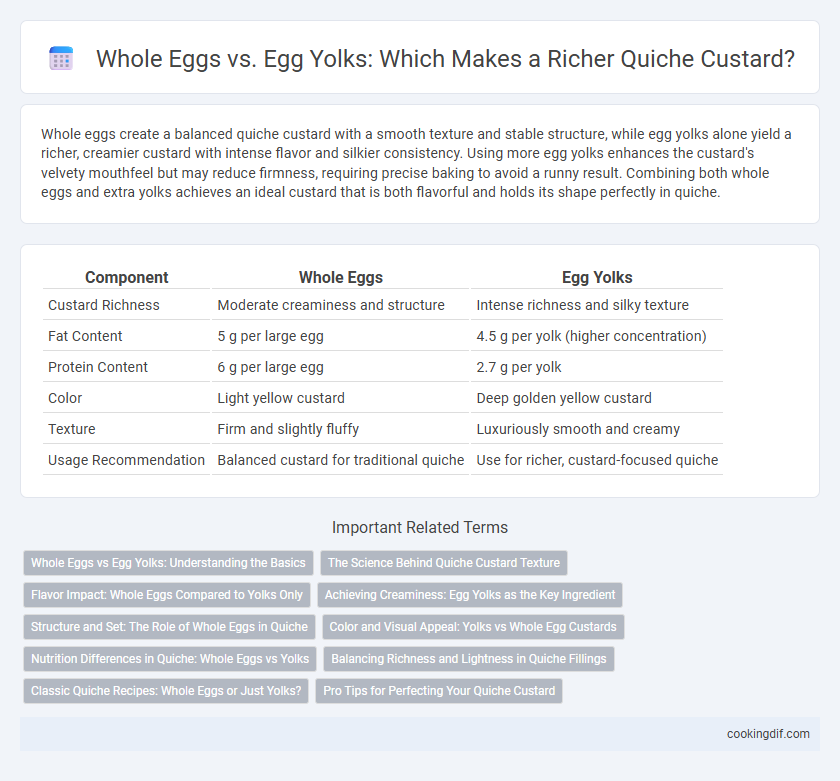Whole eggs create a balanced quiche custard with a smooth texture and stable structure, while egg yolks alone yield a richer, creamier custard with intense flavor and silkier consistency. Using more egg yolks enhances the custard's velvety mouthfeel but may reduce firmness, requiring precise baking to avoid a runny result. Combining both whole eggs and extra yolks achieves an ideal custard that is both flavorful and holds its shape perfectly in quiche.
Table of Comparison
| Component | Whole Eggs | Egg Yolks |
|---|---|---|
| Custard Richness | Moderate creaminess and structure | Intense richness and silky texture |
| Fat Content | 5 g per large egg | 4.5 g per yolk (higher concentration) |
| Protein Content | 6 g per large egg | 2.7 g per yolk |
| Color | Light yellow custard | Deep golden yellow custard |
| Texture | Firm and slightly fluffy | Luxuriously smooth and creamy |
| Usage Recommendation | Balanced custard for traditional quiche | Use for richer, custard-focused quiche |
Whole Eggs vs Egg Yolks: Understanding the Basics
Whole eggs provide a balanced texture and structure in quiche custard, combining the firmness of egg whites with the richness of yolks. Egg yolks contribute a creamier, denser custard due to their higher fat content and emulsifying properties. Using a higher ratio of yolks enhances the custard's silkiness and flavor intensity, while whole eggs ensure a more stable, set custard.
The Science Behind Quiche Custard Texture
Whole eggs contribute a balanced protein and fat content that firms up the quiche custard without making it rubbery, while egg yolks add higher fat levels that enhance creaminess and richness. The proteins in egg whites coagulate at lower temperatures creating structure, whereas the fats in yolks prevent over-tightening of proteins, resulting in a silky, smooth texture. Optimizing the ratio of whole eggs to yolks fine-tunes the custard's firmness and richness by controlling protein network formation and fat emulsification during baking.
Flavor Impact: Whole Eggs Compared to Yolks Only
Using whole eggs in quiche custard delivers a balanced texture and a mild flavor, contributing to a traditional, creamy consistency. Egg yolks alone intensify richness and impart a deeper, buttery taste due to their higher fat content and emulsifying properties. The choice between whole eggs and yolks directly affects custard density and flavor depth, with yolks providing a more gourmet, velvety experience.
Achieving Creaminess: Egg Yolks as the Key Ingredient
Egg yolks are essential for achieving a richer, creamier quiche custard due to their higher fat content compared to whole eggs. The natural emulsifiers in yolks, such as lecithin, create a smooth, velvety texture that enhances mouthfeel and flavor depth. Using only yolks or a higher yolk-to-white ratio intensifies custard richness, elevating the overall indulgence of the quiche.
Structure and Set: The Role of Whole Eggs in Quiche
Whole eggs play a crucial role in achieving the ideal structure and set in quiche custard by providing a balance of protein and fat that egg yolks alone cannot offer. The proteins in whole eggs coagulate during baking, creating a firm yet tender texture that supports the quiche filling. Using only egg yolks results in a denser, creamier custard but lacks the stability and proper set needed for slicing.
Color and Visual Appeal: Yolks vs Whole Egg Custards
Using egg yolks alone in quiche custard creates a deeper golden color, enhancing the quiche's visual appeal with a rich, vibrant hue. Whole egg custards tend to have a lighter, more pale yellow shade, resulting in a subtler, creamier appearance. The intense color from yolks signals a richer texture and flavor, attracting attention for gourmet presentations.
Nutrition Differences in Quiche: Whole Eggs vs Yolks
Whole eggs provide balanced nutrition in quiche custard by combining protein, fat, and essential vitamins like B12 and D, whereas egg yolks are rich in healthy fats, cholesterol, and fat-soluble vitamins A, D, E, and K, contributing to a creamier texture. Using more yolks enhances richness and mouthfeel but increases calorie and cholesterol content, potentially affecting heart health. Choosing whole eggs results in a lighter custard with higher protein content, making it a more nutrient-dense option for those monitoring intake.
Balancing Richness and Lightness in Quiche Fillings
Using whole eggs in quiche custard creates a balance between richness and lightness, as the egg whites provide structure and the yolks contribute creaminess. Incorporating extra egg yolks intensifies the custard's richness and results in a denser texture, ideal for indulgent quiches. Adjusting the ratio of whole eggs to yolks allows precise control over the custard's silkiness and firmness, ensuring a perfect balance tailored to individual taste preferences.
Classic Quiche Recipes: Whole Eggs or Just Yolks?
Classic quiche recipes achieve a richer custard texture by using egg yolks instead of whole eggs, as the yolks contribute more fat and creaminess essential for a velvety filling. Whole eggs provide structure and firmness, but incorporating extra yolks enhances the richness and smoothness that defines traditional quiche Lorraine or spinach quiche variants. Balancing whole eggs with additional yolks creates an ideal custard consistency that holds well during baking while delivering an indulgent mouthfeel.
Pro Tips for Perfecting Your Quiche Custard
Using whole eggs provides a balanced structure and tenderness to quiche custard, while incorporating extra egg yolks enhances richness and creaminess due to higher fat content. For a velvety, luscious texture, a common ratio is 3 whole eggs to 2 egg yolks per 1 cup of dairy, optimizing custard firmness without dryness. Precise temperature control during baking, around 325degF to 350degF, helps achieve a smooth, custard-like consistency by preventing curdling and overcooking.
Whole eggs vs egg yolks for richer quiche custard Infographic

 cookingdif.com
cookingdif.com